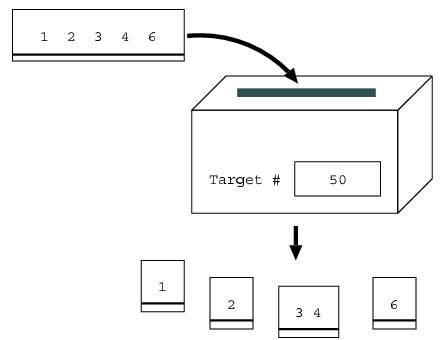POJ-1416-Shredding Company(模拟+dfs)
来源:互联网 发布:手机虚拟摄像头软件 编辑:程序博客网 时间:2024/05/18 03:53
Shredding Company
Time Limit: 1000MS Memory Limit: 10000KTotal Submissions: 4397 Accepted: 2519
Description
You have just been put in charge of developing a new shredder for the Shredding Company Although a "normal" shredder would just shred sheets of paper into little pieces so that the contents would become unreadable, this new shredder needs to have the following unusual basic characteristics.
1.The shredder takes as input a target number and a sheet of paper with a number written on it.
2.It shreds (or cuts) the sheet into pieces each of which has one or more digits on it.
3.The sum of the numbers written on each piece is the closest possible number to the target number, without going over it.
For example, suppose that the target number is 50, and the sheet of paper has the number 12346. The shredder would cut the sheet into four pieces, where one piece has 1, another has 2, the third has 34, and the fourth has 6. This is because their sum 43 (= 1 + 2 + 34 + 6) is closest to the target number 50 of all possible combinations without going over 50. For example, a combination where the pieces are 1, 23, 4, and 6 is not valid, because the sum of this combination 34 (= 1 + 23 + 4 + 6) is less than the above combination's 43. The combination of 12, 34, and 6 is not valid either, because the sum 52 (= 12 + 34 + 6) is greater than the target number of 50.

Figure 1. Shredding a sheet of paper having the number 12346 when the target number is 50
There are also three special rules :
1.If the target number is the same as the number on the sheet of paper, then the paper is not cut.
For example, if the target number is 100 and the number on the sheet of paper is also 100, then
the paper is not cut.
2.If it is not possible to make any combination whose sum is less than or equal to the target number, then error is printed on a display. For example, if the target number is 1 and the number on the sheet of paper is 123, it is not possible to make any valid combination, as the combination with the smallest possible sum is 1, 2, 3. The sum for this combination is 6, which is greater than the target number, and thus error is printed.
3.If there is more than one possible combination where the sum is closest to the target number without going over it, then rejected is printed on a display. For example, if the target number is 15, and the number on the sheet of paper is 111, then there are two possible combinations with the highest possible sum of 12: (a) 1 and 11 and (b) 11 and 1; thus rejected is printed. In order to develop such a shredder, you have decided to first make a simple program that would simulate the above characteristics and rules. Given two numbers, where the first is the target number and the second is the number on the sheet of paper to be shredded, you need to figure out how the shredder should "cut up" the second number.
1.The shredder takes as input a target number and a sheet of paper with a number written on it.
2.It shreds (or cuts) the sheet into pieces each of which has one or more digits on it.
3.The sum of the numbers written on each piece is the closest possible number to the target number, without going over it.
For example, suppose that the target number is 50, and the sheet of paper has the number 12346. The shredder would cut the sheet into four pieces, where one piece has 1, another has 2, the third has 34, and the fourth has 6. This is because their sum 43 (= 1 + 2 + 34 + 6) is closest to the target number 50 of all possible combinations without going over 50. For example, a combination where the pieces are 1, 23, 4, and 6 is not valid, because the sum of this combination 34 (= 1 + 23 + 4 + 6) is less than the above combination's 43. The combination of 12, 34, and 6 is not valid either, because the sum 52 (= 12 + 34 + 6) is greater than the target number of 50.

Figure 1. Shredding a sheet of paper having the number 12346 when the target number is 50
There are also three special rules :
1.If the target number is the same as the number on the sheet of paper, then the paper is not cut.
For example, if the target number is 100 and the number on the sheet of paper is also 100, then
the paper is not cut.
2.If it is not possible to make any combination whose sum is less than or equal to the target number, then error is printed on a display. For example, if the target number is 1 and the number on the sheet of paper is 123, it is not possible to make any valid combination, as the combination with the smallest possible sum is 1, 2, 3. The sum for this combination is 6, which is greater than the target number, and thus error is printed.
3.If there is more than one possible combination where the sum is closest to the target number without going over it, then rejected is printed on a display. For example, if the target number is 15, and the number on the sheet of paper is 111, then there are two possible combinations with the highest possible sum of 12: (a) 1 and 11 and (b) 11 and 1; thus rejected is printed. In order to develop such a shredder, you have decided to first make a simple program that would simulate the above characteristics and rules. Given two numbers, where the first is the target number and the second is the number on the sheet of paper to be shredded, you need to figure out how the shredder should "cut up" the second number.
Input
The input consists of several test cases, each on one line, as follows :
tl num1
t2 num2
...
tn numn
0 0
Each test case consists of the following two positive integers, which are separated by one space : (1) the first integer (ti above) is the target number, (2) the second integer (numi above) is the number that is on the paper to be shredded.
Neither integers may have a 0 as the first digit, e.g., 123 is allowed but 0123 is not. You may assume that both integers are at most 6 digits in length. A line consisting of two zeros signals the end of the input.
tl num1
t2 num2
...
tn numn
0 0
Each test case consists of the following two positive integers, which are separated by one space : (1) the first integer (ti above) is the target number, (2) the second integer (numi above) is the number that is on the paper to be shredded.
Neither integers may have a 0 as the first digit, e.g., 123 is allowed but 0123 is not. You may assume that both integers are at most 6 digits in length. A line consisting of two zeros signals the end of the input.
Output
For each test case in the input, the corresponding output takes one of the following three types :
sum part1 part2 ...
rejected
error
In the first type, partj and sum have the following meaning :
1.Each partj is a number on one piece of shredded paper. The order of partj corresponds to the order of the original digits on the sheet of paper.
2.sum is the sum of the numbers after being shredded, i.e., sum = part1 + part2 +...
Each number should be separated by one space.
The message error is printed if it is not possible to make any combination, and rejected if there is
more than one possible combination.
No extra characters including spaces are allowed at the beginning of each line, nor at the end of each line.
sum part1 part2 ...
rejected
error
In the first type, partj and sum have the following meaning :
1.Each partj is a number on one piece of shredded paper. The order of partj corresponds to the order of the original digits on the sheet of paper.
2.sum is the sum of the numbers after being shredded, i.e., sum = part1 + part2 +...
Each number should be separated by one space.
The message error is printed if it is not possible to make any combination, and rejected if there is
more than one possible combination.
No extra characters including spaces are allowed at the beginning of each line, nor at the end of each line.
Sample Input
50 12346376 144139927438 92743818 33129 314225 1299111 33333103 8621506 11040 0
Sample Output
43 1 2 34 6283 144 139927438 92743818 3 3 12error21 1 2 9 9rejected103 86 2 15 0rejected传送门
题意:
给一个目标数字,再给一个上面写着数字的纸,剪纸机可以再纸片的任何位置剪纸,剪下来的数字碎片的和最接近目标数字就输出剪纸方案,
有几个规则的细节:剪下来的数字和不能超过目标数字,所以dfs时可以利用这点剪枝。
若所有的剪纸方案所产生的数字之和都要大于目标数字,那么输出error。
若存在两种及以上的方案,那么输出rejected。
思路:DFS,细节比较多,比如用一个ans数组记录剪纸方案,如何让模拟剪纸过程,如何让记录方案个数都有一定的细节,所有对我目前的水平来说有一定的锻炼能力。
//Memory: 360 KBTime: 0 MS#include<cstdio>#include<cstring>#define inf 0x7fffffffusing namespace std;int s,g;int wei,minn,cnt;int stc[110],top,flag;int ans[110];void ini(){ cnt=wei=1; top=flag=0; minn=inf; int tmp=s; while(tmp/=10) wei++; //计算纸片上的数字是多少位}void dfs(int le,int sum,int pos) //le表示当前纸片上剩余的数字,sum是当前剪下来纸片数字之和{ //pos是当前剪或不剪纸片上的第几位数 if(sum>g) return; //剪枝 if(pos==0){ if(g-sum<minn) { minn=g-sum; flag=1; for(int i=1;i<=top;i++) ans[i]=stc[i];//用ans记录每次更接近目标的剪成的碎片。 for(int i=top+1;i<110;i++) ans[i]=-1;//小技巧,如果不加这步就残留了ans数组后面 //的一些数,并不是这轮剪纸所产生的数 cnt=1; //细节,当前是更接近目标的方案,目前只有一种方案。 return ; } if(g-sum==minn) { for(int i=1;i<=top;i++) ans[i]=stc[i]; for(int i=top+1;i<110;i++) ans[i]=-1; cnt++; //细节,记录当前达到最接近目标的剪纸有几种剪纸方法 return; } if(g-sum>minn) return; } int tmp=1; for(int i=1;i<pos;i++) tmp*=10; //以下三行在模拟如何从pos的位置上剪开 int nxs=sum+le/tmp; int nxl=le%tmp; stc[++top]=le/tmp; dfs(nxl,nxs,pos-1); top--; if(pos!=1) {//细节,pos=1的时候不需要剪,或说已经被剪好了,因为纸片的末尾必然是断开的 dfs(le,sum,pos-1); }}int main(){ while(~scanf("%d%d",&g,&s)&&(s||g)){ ini(); dfs(s,0,wei); if(cnt>=2) printf("rejected\n"); else if(!flag) printf("error\n"); else{ printf("%d",g-minn); for(int i=1;i<110;i++){ if(ans[i]!=-1) printf(" %d",ans[i]); } puts(""); } } return 0;} 0 0
- POJ-1416-Shredding Company(模拟+dfs)
- poj 1416 Shredding Company (DFS)
- POJ 1416 Shredding Company(简单DFS)
- poj 1416 Shredding Company(DFS减枝)
- poj 1416 Shredding Company(DFS)
- POJ 1416 Shredding Company (DFS)
- poj-1416-Shredding Company-dfs
- poj 1416 Shredding Company dfs
- poj 1416 Shredding Company (dfs)
- poj -1416-Shredding Company-DFS
- poj-1416 Shredding Company DFS
- [POJ 1416]Shredding Company[DFS]
- POJ-1416 Shredding Company(DFS)
- POJ.1416 Shredding Company (DFS)
- poj 1416 Shredding Company(dfs)
- Poj 1416 Shredding Company 【dfs】
- POJ 1416 Shredding Company <DFS>
- POJ 1416 && HDU 1539 Shredding Company(dfs)
- 一日总结
- Android的Handler及looper
- Java泛型的擦除是完全的吗?
- 编写一个程序用于执行矩阵的乘法。 m1是一个x行y列的矩阵,m2是y行z列的矩阵。 这两个矩阵应该相乘,结果存储在r中,它是x行z列的矩阵。
- bat 批处理命令 文件 类型 语法 格式 应用 详解(转)
- POJ-1416-Shredding Company(模拟+dfs)
- 使用线程下载网络图片
- JAVA小技巧
- 单元测试利器 JUnit 4
- [Leetcode]Best Time to Buy and Sell Stock
- HDU 1258 Sum It Up
- ROS launch整理
- ContentProvider详细用法记录和总结
- project scheduling tool - GanttProject


